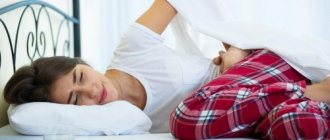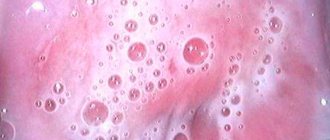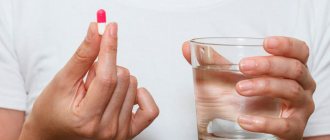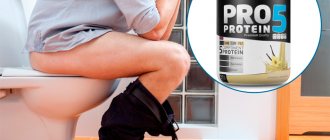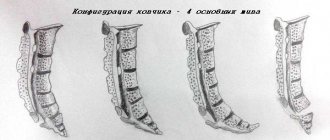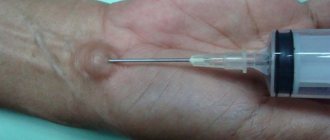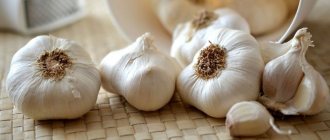Prevention of antibiotic-associated diarrhea
When treated with antibiotics, the number of microbes sensitive to them decreases and the growth of normal intestinal microflora is inhibited.
The number of antibiotic-resistant strains is increasing. Opportunistic bacteria multiply rapidly and begin to acquire properties that damage the macroorganism. Clostridia, staphylococci, Proteus, enterococci, Pseudomonas aeruginosa, Klebsiella and yeast-like fungi are the most well-known representatives of pathogenic intestinal flora. In most cases of diarrhea that occurs after antibiotics, the leading place is occupied by clostridia (Clostridium difficile). The frequency of their damage is:
- from 15 to 30% of cases with antibiotic-associated diarrhea (AAD);
- from 50 to 75% of cases with antibiotic-associated colitis;
- up to 90% of cases with pseudomembranous colitis.
Rice. 2. Photo of Clostridium difficile under a microscope.
Rice. 3. The photo shows a colony of Clostridium difficile.
The cause of diarrhea (diarrhea) and colitis is a violation of the intestinal microbiocenosis (intestinal dysbiosis). The growth of pathogenic bacteria leads to damage to the intestinal wall and increased secretion of electrolytes and water.
Intestinal microflora is involved in the utilization of fiber. As a result of this process, short-chain fatty acids are formed - a source of energy for the intestinal mucosa.
With an insufficient amount of fiber in the human diet, the trophism (nutrition) of intestinal tissues is disrupted, which leads to increased permeability of the intestinal barrier to toxins and pathogenic microbial flora.
Enzymes produced by intestinal microflora take part in the process of breaking down bile acids. After being released into the gastrointestinal tract, secondary bile acids are reabsorbed, and a small amount of them (5 - 15%) is excreted in the feces, participating in the formation and movement of feces and preventing their dehydration.
If there are too many bacteria in the intestines, then bile acids begin to break down prematurely, which leads to secretory diarrhea (diarrhea) and steatorrhea (excretion of increased amounts of fat).
All of the above factors form:
- Antibiotic-associated diarrhea is the most common complication of antibacterial treatment in adults. The incidence of this complication ranges from 5 to 25% in people taking antibiotics;
- The development of colitis is somewhat less common;
- A rare but serious disease that develops after antibiotics is pseudomembranous colitis.
Rice. 4. The photo shows a normal intestinal wall (histological specimen).
The clinical picture of dysbiosis after antibiotics has a wide range of manifestations - from minimal to life-threatening. In 70% of patients, symptoms of the disease appear during the treatment period. In 30% of patients - after completion of treatment.
- Initially, loose stools (diarrhea) without any impurities. It often goes away on its own within 3 to 4 days. Sometimes the patient is bothered by cramping pain in the abdomen. The general condition of the patient is quite satisfactory. Endoscopic picture of AAD without pathology. With the development of colitis, inflammation of the intestinal wall (swelling and hyperemia) is noted.
- With the negative development of the disease, the severity of the process increases, symptoms such as fever appear, stools become more frequent, the level of leukocytes in the blood increases, leukocytes appear in the stool, and pseudomembranous colitis gradually develops, caused by clostridia.
Pseudomembranous colitis often develops during treatment with antibiotics, less often - 7-10 days after their discontinuation. It is based on the activation of pathogenic flora and primarily clostridia (Clostridium difficile). Cases of the development of colitis as a result of the proliferation of staphylococci, Klebsiella, Salmonella and Candida fungi have been described. Among all pseudomembranous colitis, colitis caused by antibiotic use ranges from 60 to 85% in adults.
Clostridia produce toxins that lead to inflammation of the intestinal mucosa. Contacts between cells (enterocytes) are disrupted, which leads to increased permeability of the intestinal wall with the subsequent development of symptoms such as diarrhea, fever, and cramps. The inflammatory process is localized more often in the large intestine, less often in the small intestine.
Rice. 6. The photo shows a classic “volcano” lesion in pseudomembranous colitis (histological picture). The process of exudation has gone beyond the mucous membrane of the ulcer, and the process of formation of fibrous films begins. Symptoms of the disease increase rapidly during this period.
The disease is characterized by loose, scanty, watery stools with a frequency of 10 to 30 times a day, abdominal pain and fever. Diarrhea persists for 8 to 10 weeks. Persistent diarrhea leads to loss of electrolytes and water. The volume of circulating blood decreases, blood pressure decreases. Severe dehydration develops. A decrease in the level of albumin in the blood leads to the development of peripheral edema.
Leukocytosis in the blood reaches 15 109/l. In some cases, higher rates are observed. A decrease in the number of leukocytes is recorded in patients who received chemotherapy for cancer. The colon becomes damaged, dilates (toxic dilatation), and perforates. If timely and adequate assistance is not provided, the disease often ends in the death of the patient.
For diarrhea caused by taking antibiotics, endoscopy does not reveal any changes. With the development of colitis, catarrhal inflammation first appears. Further, against the background of hyperemia and edema of the intestinal wall, erosions appear.
During endoscopy for pseudomembranous colitis, fibrinous films (pseuvomembranes) are observed on the intestinal mucosa, which form in areas of necrosis of the mucous membrane. Fibrinous films have a pale yellowish color, often ribbon-shaped. Their size ranges from 0.5 to 2 cm in diameter.
Rice. 7. The photo shows pseudomembranous colitis. Yellowish fibrous films (pseudomembranes) are visible.
A computed tomography scan reveals a thickened wall of the large intestine.
Complications
Infectious-toxic shock, perforation of the large intestine and peritonitis are serious complications of pseudomembranous colitis in adults. When they develop, conventional therapy is powerless. Removing part of the intestine is the only treatment.
The fulminant form of the disease is fatal in half of the cases.
Diagnosis of the disease is based on the determination of enterotoxins A and B of Clostridium difficile in the stool.
The latex agglutination test is a qualitative method for diagnosing pseudomembranous colitis. It allows you to detect the presence of enterotoxin A in stool within one hour. Its sensitivity and specificity are high and amount to more than 80%.
Rice. 8. The photo shows a view of the intestine with pseudomembranous colitis. Ribbon-shaped pseudomembranes are visible, covering a large area of the intestine (macropreparation).
The drugs of choice for the treatment of pseudomembranous colitis in adults are the antimicrobial drugs vancomycin and metronidazole.
Read in detail the article “After antibiotics: restoration of intestinal microflora.”
The following rules can prevent the negative consequences of taking antibiotics:
- Take medications prescribed by your doctor after a series of tests for the sensitivity of pathogenic microflora to antibiotics. Self-diagnosis based on personal feelings, the experience of friends, and information from the Internet often turns out to be erroneous. People start taking antibiotics due to a viral illness, for which they are useless.
- Eat vegetables, fruits, buckwheat porridge, oats, peas, and bran bread.
- Make it a rule to drink a glass of fermented milk drink 2 hours before bedtime.
- Strengthen the immune system through moderate hardening, age-appropriate physical training, and a rational regime of work and rest.
- Regularly undergo medical examinations for early detection of diseases of the gastrointestinal tract and other body systems.
Bacteria and microscopic fungi are the oldest inhabitants of the planet. The symbionts, having adapted to life inside humans, protect their possessions from the penetration of “strangers.” Antibiotics make significant gaps in the ranks of the defenders and open the gates for uninvited guests. Diarrhea that occurs during antibiotic therapy can be cured by using probiotics, a fiber-rich diet, and strengthening the immune system.
Is it possible to get infected from animals?
Veterinarians know the disease as bovine viral diarrhea. The pathogen belongs to the family Togaviridae. It affects young animals on farms. Calves and cows under two years of age are affected. Buffalo, sheep, roe deer, goats, and deer are susceptible.
Sick calves are wrapped to keep them warm
It is transmitted from sick animals through feces and nasal discharge. It affects intestinal epithelial cells, causing ulceration, severe intoxication, diarrhea, dehydration, lameness, and stomatitis. Up to 10% of animals die. Outbreaks are more common during the cold season.
In large farms, double vaccination is used; it allows you to maintain immunity for up to five years, not transmit infection to offspring, and preserve the herd. Meat and the resulting by-products undergo inspection and, based on the conclusion of veterinary and sanitary supervision, are allowed for processing for the production of boiled and boiled-smoked sausages and canned food. The danger of the disease to humans has not been proven.
Why does diarrhea occur after antibiotics?
Diarrhea when taking antibiotics is caused by the ability of antibacterial drugs to suppress beneficial intestinal microflora, which supports the natural functioning of the gastrointestinal tract. At the same time, a number of pathogenic microbes located in the digestive organs become resistant to antibacterial agents.
During life, pathogenic microflora releases toxins that poison the patient’s body. This is how dysbiosis occurs, which is often accompanied by diarrhea. A number of macrolide antibiotics have a strong laxative effect. They promote the production of the hormone motilin in the patient’s body, which excessively activates intestinal motility.
The likelihood of a side effect in the form of diarrhea when treating a patient with an antibiotic is higher, the longer the patient takes this medicine. In view of the serious condition of a person who finds himself in a hospital bed, it is sometimes justified for the attending physician to prescribe a complex treatment regimen with a combination of several antiprotozoal drugs or increased doses of an antibiotic. In this case, the risk of diarrhea during treatment increases. Patients at risk for intestinal dysbiosis include:
- older;
- with weakened immunity due to chronic diseases;
- which are fed using a gastric tube;
- during pregnancy or postpartum period;
- with HIV infection;
- cancer, while simultaneously taking chemotherapy.
When prescribing antibiotics to treat a particular disease, the doctor must warn the patient about a possible side effect from taking the drug - diarrhea. The doctor is obliged to advise the patient on how to act if an unpleasant symptom appears. Examples of antibiotics that cause intestinal upset:
- macrolides: Erythromycin, Clarithromycin, Azithromipine;
- tetracyclines: Doxycycline, Tetracycline;
- aminoglycosides: Gentamicin, Amikacin, Streptomycin;
- clindamycins: Dalatsin, Klimitsin;
- cephalosporins: Cefazolin, Cefaclor, Cefaperazone;
- penicillins: Ampicillin, Benzylpenicillin.
How to treat instead of antibiotics when taking them is inappropriate
In addition, it is not recommended to take antibiotics if diarrhea is caused by decreased intestinal motility or non-bacterial etiology. It is enough to take only medications belonging to the group of anticholinergics, such as Atropine, Parfen, Metacin, Platyphylline, Ephedrine. They block acetylcholine, which increases intestinal motility.
It is unacceptable to prescribe treatment for diarrhea on your own. For symptoms of unknown etiology, consultation with a general practitioner, infectious disease specialist and gastroenterologist is required. After undergoing a comprehensive examination, the cause of the gastrointestinal tract disorder will be determined, and if necessary, antibacterial therapy will be prescribed.
https://youtu.be/riamfMkNA1o
Antibiotics that cause diarrhea
Penicillins
Penicillins of earlier generations (ampicillin, benzylpenicillin) more often affect the intestinal microflora. The use of modern penicillins does not lead to the development of clostridia - the main culprits of pseudomembranous colitis.
Cephalosporins
Most cephalosporins promote the growth of enterobacteria and clostridia. Cefaclor and cefradine do not affect the intestinal biocenosis.
Erythromycin
M-cells of the epithelium of the small intestine produce the hormone motilin, which affects intestinal motility, promoting the movement of food through the digestive tract. Erythromycin stimulates the production of motilin, thereby accelerating the emptying of the stomach and intestines, which is manifested by diarrhea (diarrhea).
Clavulanic acid
Clavulanic acid, which is part of many antibiotics (amoxiclav, amoxicillin/clavulanate), also stimulates intestinal motility.
Tetracycline and neomycin negatively affect the intestinal epithelium, causing a direct toxic effect.
Fluoroquinolones
Antibiotics of this group suppress the growth of normal intestinal microflora, but do not promote the growth of clostridia.
Lincomycin
If a patient has loose stools for 2 days in a row, two days after starting antibiotics and up to 2 months after stopping them, antibiotic-associated diarrhea (AAD) occurs. This condition means that the patient has experienced pathological changes in the composition of the intestinal microflora (intestinal dysbiosis). Its incidence ranges from 5 to 25% among patients treated with antibiotics.
If diarrhea occurs with symptoms of intoxication and high leukocytosis, then clostridia should be considered the cause.
Rice. 5. The bulk of the intestinal microflora is concentrated in the parietal zone of the intestine.
Those at risk for developing antibiotic-associated diarrhea are:
- children aged from 2 months. up to 2 years old and adults over 65 years old,
- patients with diseases of the stomach and intestines,
- patients who were treated with antibiotics for more than 3 days,
- use in the treatment of a large number of antibiotics,
- severe immunodeficiency.
destroy the protective mucous membrane of the intestines and poison the colon with their toxins. Toxins are carried throughout the body through the bloodstream. The local process becomes general, body temperature rises, nausea and weakness appear. Unprocessed carbohydrates accumulate in the intestines. This attracts the attention of “looters”—yeasts that utilize carbohydrates, releasing alcohol and other harmful substances.
The most harmful clostridia cause pseudomembranous colitis. The disease has been known since the 50s of the last century; its spread coincided with the heyday of the era of mass use of antimicrobial medications. Most often, such a pathology while taking antibiotics occurs in adult patients over 50 years of age who have been in hospitals for a long time.
In clostridial colitis, the intestinal wall undergoes necrosis. Deep ulcers and purulent infiltrates form at the site of the lesion. The function of the organ is completely disrupted; accordingly, the food lump quickly “flies” through the thick section and “enriches” itself with blood, pus, and mucus along the way. The bowel disorder is permanent. Symptoms of the extreme form of clostridial intestinal damage: mucous, foul-smelling diarrhea, nausea, vomiting, dehydration.
Diarrhea from antibiotics may not occur immediately, but within 2 days to 2 months. In more than half of cases, diarrhea in adults goes away on its own after stopping taking the medication. The method of administration of the drug - orally, intramuscularly, intravenously - does not affect the degree and severity of the consequences.
The development of intestinal dysbiosis is also caused by other conditionally pathogenic microbes, which are found in the amount of 2-3% of the total number of bacteria in a healthy intestine. These include Klebsiella, staphylococcus, salmonella, and candida. They provoke mild loose stools, which are quickly eliminated after discontinuation of antibiotics and minor dietary adjustments.
Mechanism of development of diarrhea
Loose stools after taking medication can be explained by various mechanisms.
- The most common reason is taking macrolide antibiotics. Such drugs are considered the safest, since their action is aimed at preventing bacteria from multiplying (bacteriostatic). However, doctors believe that taking them increases gastrointestinal motility and provokes diarrhea.
- Broad-spectrum antimicrobial drugs, for example, cephalosporins, help destroy good bacteria and disrupt intestinal microflora (have a bactericidal effect).
- After potent antibacterial agents, the rate of development of beneficial bacteria in the gastrointestinal tract slows down.
- With a weakened immune system and long-term use of antibiotics, favorable conditions are created for re-infection. Its consequence will be diarrhea. Characteristic clinical signs of this condition are pain, the presence of bloody impurities in the stool, and high temperature.
When infected with the pathogenic microorganism Clostridium difficile, a number of complications are possible. Doctors explain this by the high degree of resistance of bacteria to most antimicrobial drugs. The main clinical sign is considered to be sharp pain and body temperature around 38 degrees Celsius.
Doctors assess the condition as stable when the patient manages to restrain the urge for 1 - 1.5 hours. If there are no blood cells or purulent impurities in the stool, the patient does not have a fever, the situation is also considered stable.
Only a medical institution can tell you how to treat correctly. The medication should be prescribed by a doctor after diagnostic procedures and tests. The doctor needs to choose the optimal treatment method for diarrhea after antibacterial medications. To do this, it is necessary to establish the type of pathogen and determine a technique for how to cope with it with minimal likelihood of complications.
Complications
Loose stools after antibiotics may indicate the development of a serious complication caused by treatment with antibacterial drugs - pseudomembranous colitis. Diarrhea from antibiotics is very dangerous if it is accompanied by the following symptoms:
- frequency of bowel movements – 10–20 times per day;
- foul-smelling, watery stool turns green and contains mucus and blood;
- pain in the abdominal area;
- high body temperature;
- nausea, vomiting;
- severe weakness from dehydration.
Pseudomembranous colitis is caused by microbes of the genus Clostridium (lat. Clostridium difficile), which rapidly multiply in the gastrointestinal tract, poisoning the entire body with waste products. This severe form of intestinal disorder can be fatal for the patient, so when the first signs of the disease appear, immediate hospitalization is required.
Danger of dysbacteriosis
If dysbiosis with diarrhea is not treated after taking antibacterial medications, dehydration of the body develops. Frequent bowel movements remove beneficial bacteria and vitamins.
In the absence of treatment, irreversible complications for the stomach are possible. In the worst case, the patient begins to develop pseudomembranous colitis. Pathological syndrome occurs with an advanced form of gastrointestinal disorder after taking an antibiotic. The balance of bacteria in the stomach and intestines is disturbed, and the active proliferation of C. Difficile bacteria begins.
During the progression of pseudomembranous colitis, the following clinical signs occur.
- Frequency of bowel movements more than 10 times a day.
- The pathology is accompanied by severe pain.
- The stool contains admixtures of mucus and blood cells.
- Nausea occurs.
- Body temperature rises.
- The stool takes on a greenish tint and is characterized by a persistent unpleasant odor.
To make a diagnosis, the patient is prescribed a biochemical type of blood cell analysis. The course of treatment is based on the use of special medications that eliminate pathogenic flora of the gastrointestinal tract.
When treating colitis, the use of Loperamide is strictly prohibited. The drug will increase the degree of intoxication of the body.
Treatment of pseudomembranous colitis
Diarrhea when taking antibiotics should excite the patient and stimulate him to take urgent measures to prevent severe complications. Comprehensive therapy, including:
- first aid for diarrhea;
- a strict diet designed to relieve the burden on the intestines due to dysbiosis;
- drug treatment aimed at stabilizing the functioning of the gastrointestinal tract and restoring normal microflora in the digestive organs;
- the use of traditional medicine to speed up the patient’s recovery process;
- the use of preventive measures to prevent recurrence of dysbacteriosis.
First aid
How quickly you can get rid of dysbacteriosis depends on the correct actions of the patient and the people caring for him during diarrhea from antibiotic treatment. At the first signs of intestinal distress, you should:
- Parents of a sick infant should seek emergency medical help to avoid rapid dehydration of the child's body.
- Stop taking antibiotics and immediately make an appointment with your doctor. He must stop the medicine or prescribe an analogue of the drug. In some cases, the use of the same antibiotics in the form of intravenous injections helps get rid of diarrhea.
- For adult patients who have bowel movements less than 5 times a day, take 1-2 capsules of Loperamide.
- Seek emergency medical help immediately if you have abdominal pain, nausea, or high body temperature. These symptoms may indicate a suspicion of pseudomembranous colitis, a serious pathology of the gastrointestinal tract that can lead to death for the patient.
Loose stools after antibiotics require a serious approach to correcting the patient’s diet in order to quickly relieve the unpleasant symptom of dysbiosis. Adhering to a strict diet is especially important in the first 2-3 days after the onset of diarrhea. The patient's menu should be limited to viscous porridge made from buckwheat or rice. Enveloping the intestinal walls, it will relieve irritation of the mucous membrane.
Blueberry jelly has an antidiarrheal effect. Its carbohydrate composition is an excellent basis for feeding beneficial microorganisms that make up probiotics. These drugs are prescribed to a patient for intestinal upset after antibiotics. Decoctions of medicinal herbs according to the recipe of traditional healers help restore normal microflora of the gastrointestinal tract. You can use crackers made from unleavened bread or non-sweet biscuits.
In the first three days after the onset of diarrhea, it is strictly forbidden to eat dairy products, fried, and fatty foods. It is recommended to drink large quantities of unsweetened apple and pear compote, tea and boiled water to avoid dehydration. After a few days of a strict diet, you can gradually introduce into the patient’s diet dishes (boiled, stewed, steamed) from the following products:
- vegetables and fruits rich in plant fiber, except citrus fruits;
- corn, millet groats;
- fermented milk products;
- eggs;
- lean meat and fish;
- butter, vegetable oils.
The patient should be restricted from eating black bread for another 10 days after normal stool has been restored. A patient with diarrhea after taking antibacterial agents should exclude the following foods from the diet:
- sausages;
- smoked meats;
- canned food;
- cheeses;
- ice cream;
- spices;
- semi-finished products;
- candies;
- kvass;
- food products containing dyes and preservatives.
Diarrhea after antibiotics is very dangerous. To avoid serious consequences of dysbacteriosis, the patient is given drug therapy. All medications to normalize intestinal microflora should be prescribed by the attending physician. Any attempt at self-medication can worsen the problem. For the complex treatment of a person suffering from diarrhea, the following groups of drugs are used:
- Enterosorbents are oral medications whose active components are capable of binding and removing toxins from the gastrointestinal tract. Effective agents are Enterosgel, Smecta, Polysorb, activated carbon, etc. Enterosorbents are rarely used as monopreparations. Along with other drugs, they are used for a course of 5-7 days, 3 times a day. The dosage of the medicine is used according to the instructions.
- Probiotics. Bifidobacteria and lactobacilli, which are contained in this medicine in the form of a dry concentrate, quickly multiply when they enter the patient’s body. Pathogens are replaced by healthy microflora. This process normalizes intestinal function. In medical practice, probiotics are more often used: Linex, Lactobacterin, Bifiform, etc. Their dosage and course of treatment are prescribed by the doctor.
- Prebiotics. The biological carbohydrate structure of these drugs is fermented by beneficial intestinal bacteria and promotes their active reproduction. Examples of prebiotics: Hilak forte, Lactusan, Duphalac, Lactulose, etc. Take the medicine 3-4 times a day with meals. The course is determined by the attending physician.
- Rehydrants are powdered preparations for the preparation of aqueous solutions that restore the water balance of the internal environment of the body. Regidron and Normohydron consist of salt, glucose and a number of vitamins. They are especially necessary for children with diarrhea from antibiotics. An aqueous solution of the drug is taken orally, regardless of food. The required volume of drink and dosage regimen are prescribed by the doctor depending on the severity of the patient’s condition.
- Antibiotics. Nifuroxazide, Enterofuril, Metronidazole are prescribed to suppress the causative agents of pseudomembranous colitis (severe pathology of the rectum) - anaerobic bacteria of the genus Clostridia. The drug is taken strictly as prescribed by the doctor, who determines the dosage and course of use.
Folk remedies
In consultation with your doctor, you can use folk remedies against diarrhea from antibiotics as an additional measure to the drug treatment of diarrhea. Effective recipes for folk remedies (use until diarrhea stops):
- 1 tbsp. Pour a spoonful of barley grains into a saucepan, pour a glass of boiling water, cook over low heat for 15 minutes. Strain the broth and take 2 tbsp. spoons 4 times a day 30 minutes before meals.
- 1 tbsp. Add a spoonful of dried blueberries to 200 ml of water and cook for 10 minutes. Cool the prepared broth and drink twice a day 30 minutes before meals. Prepare a new portion of the decoction before use.
- 1 tbsp. Pour 400 ml of boiling water over a spoonful of dill seeds and leave until completely cool. Take 100 ml of dill water daily 3-4 times before meals.
Microorganisms appeared on Earth millions of years before humans. Their adaptive abilities are unique and limitless: microbes are found both in the mouths of volcanoes and in permafrost. Bacteria that have adapted to life inside another organism and help it in vital processes are called “symbionts”.
The symbiotic intestinal microflora is formed throughout life and is an individual characteristic. Each person has his own colonies of beneficial bacteria, with which he peacefully coexists for many years. They help digestion, synthesize some B vitamins, and do not allow foreign pathogenic microbes into their “home.”
Diarrhea is accompanied not only by discomfort, but also by pain in the intestines and stomach. Frequent visits to the toilet over a long period lead to weight loss, provoke a lack of vitamins in the body, weaken the immune system and increase the process of dehydration.
This situation is extremely dangerous for pediatric patients from birth to 5 years, since a fluid loss of 10% or more poses a threat to the child’s life. Due to the fact that it is sometimes difficult for parents to force their child to drink fluid in the right amount, the only way to eliminate dehydration is a dropper. If diarrhea progresses in an infant, it is necessary to call an ambulance.
Emergency help
What to do in a critical situation, if diarrhea leads to dehydration while taking antibiotics? The child's condition must be assessed by external signs. These include lethargy, dry skin, periodic fainting, and lack of urination for more than 3 hours. In this situation, hospitalization and treatment in a hospital are indicated. If the loss of fluid in the body is insignificant, you should consult a doctor to adjust and replace medications.
What to do if diarrhea does not stop after antibiotics in an adult? You need to take first aid measures and then consult a doctor for consultation and a course of treatment. For mild diarrhea as a result of using antimicrobial drugs, taking probiotics will help restore the microflora.
If your doctor suspects such a serious illness, you should stop taking antibiotics. The patient is admitted to the hospital for examination. Colitis, together with taking antibacterial medications, threatens the patient’s life. The frequency of bowel movements in the intestinal tract can reach 21 times a day, which provokes a severe stage of dehydration. Intoxication develops.
Treatment without consulting a medical specialist is prohibited. The use of Loperamide and other similar drugs in case of progression of diarrhea after antibiotics enhances the process of poisoning and provokes the development of megacolon or deformation of the large intestine.
Any pathological syndromes of the stomach and intestines are treated with diet. If dysbiosis increases, doctors advise reducing the load on the gastrointestinal tract. You should adhere to a fractional nutrition method. The number of meals needs to be increased, but the portions should be small. Sweets and fried foods increase fermentation processes in the intestines and complicate digestion, so they should be excluded from the diet. During the first 1-2 days you should adhere to a strict diet.
- Porridges and cereals are allowed. Rice has a positive effect on irritated mucous membranes. Rice porridge is recommended to relieve diarrhea after antibiotics in children.
- Kissels based on berries or fruits restore the functioning of the gastrointestinal tract; vitamin complexes are necessary as preventive measures for vitamin deficiency. Many people prefer blueberry compote; this berry has an antidiarrheal effect.
- It is recommended to add crackers to the menu. It’s better to cook them yourself, without adding sugar.
Proper nutrition and drinking regime
Human nutrition plays an important role in eliminating antibiotic diarrhea. The diet should contain only those foods that do not burden the intestines and do not cause fermentation and putrefactive processes in it. Experts recommend lowering caloric intake by reducing the consumption of fatty foods and foods containing carbohydrates.
You need to eat often, but in small portions. Ideally, the break between meals will be 3-4 hours. Eating solid food is prohibited. It should be ground and semi-liquid, boiled or steamed. On the first day of diarrhea, it is recommended to completely avoid consuming any food and drink only liquids, such as tea.
On the second day, the diet can be varied with rice porridge, cooked without adding oil, blueberry jelly and white breadcrumbs. The following foods will be beneficial for the intestines during the development of antibiotic diarrhea:
We recommend reading:
How to cure intestinal dysbiosis
- mashed potatoes;
- thin soup;
- baked apples;
- chicken eggs;
- saltine crackers and biscuits.
As for prohibited foods for diarrhea, these include:
- smoked meats;
- carbonated drinks, alcoholic products;
- roast;
- marinade and pickles;
- citrus;
- baked goods and confectionery products;
- nuts;
- legumes;
- dairy products.
Switching to regular food consumed before the development of diarrhea is allowed only after 5–7 days. As soon as the stool has returned to normal, you can include steamed cutlets, low-fat broths, vegetable soups, and cottage cheese in your diet.
The volume of liquid consumed per day should not be less than 1.5 liters
Prevention
Diarrhea from antibiotics often occurs against the background of dysbiosis provoked by the aggressive action of medications. It is difficult to treat diarrhea when intestinal bioflora is disturbed. Therapy takes, on average, at least a week. Prevention of the negative effects of antibacterial drugs on the patient’s body:
- do not resort to self-medication;
- If diarrhea occurs during treatment, immediately contact your doctor for advice;
- strictly adhere to the dosage, regimen of taking antibacterial drugs and maintain the course of therapy prescribed by the doctor;
- do not replace prescribed antibiotics with their analogues without a doctor’s recommendation;
- take probiotics along with antibacterial drugs to reduce the likelihood of dysbiosis.
Who is more susceptible
There are several groups of people who have an increased tendency to develop diarrhea after taking an antibiotic drug.
- Elderly people.
- Patients suffering from pathological gastrointestinal syndromes, both acute and chronic.
- In the presence of concomitant somatic diseases.
Diarrhea after antibiotics develops against the background of a violation of the course of administration, an overdose, or non-compliance with the instructions for using the drug.
conclusions
Intestinal dysbiosis is an underlying condition that occurs for a variety of reasons. Almost every person experiences dysbiosis during their life. In most cases, this condition occurs without visible symptoms and goes away without leaving a trace without treatment, without affecting general well-being. If the situation develops negatively, symptoms appear, the main of which are diarrhea (diarrhea). One of the reasons for the development of dysbiosis is the use of antibiotics.
How often have you taken antibiotics without a doctor's prescription? Have you ever had problems with bowel movements (diarrhea) after taking antibiotics?
Signs of a bacterial infection
According to statistics, most people experience diarrhea as a result of a bacterial infection. It can enter the body with contaminated water, unwashed food, or as a result of failure to comply with basic hygiene.
The doctor will prescribe an antibiotic if the patient exhibits the following symptoms:
- copious discharge;
- loose stools with green speckles or green mucus;
- a lot of mucus is produced;
- there is bleeding.
If you notice that bloody diarrhea has begun, you should urgently seek medical help. This symptom is very alarming; it may indicate the development of a tumor in the intestines, hemorrhoids, or Crohn's disease.
